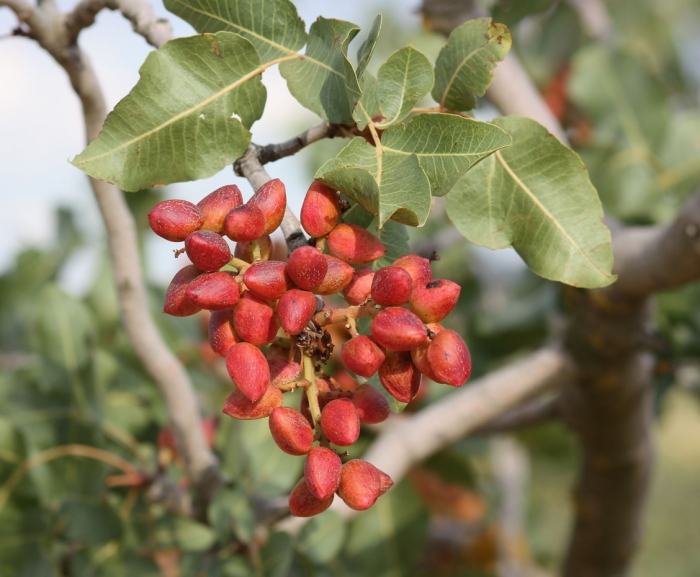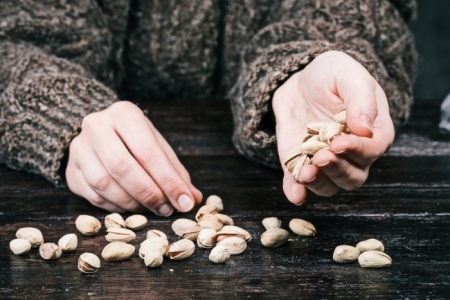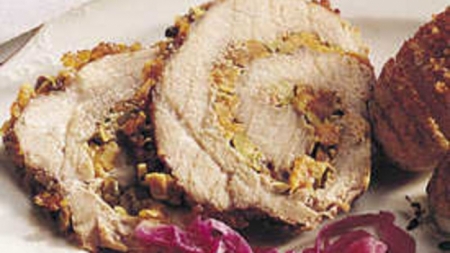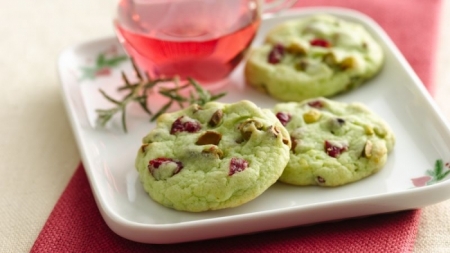Posted on Wednesday, September 20, 2017
Did you know that hearing the crack of a pistachio shell is considered good luck in some countries? What about this nut’s distant cousins—mangos and poison ivy? Then there’s the whole weird green color (thanks to chlorophyll), and we’ve heard talk of Turkey wanting to fuel a town entirely on pistachio shells.
Needless to say, there’s a lot to about this strange nut and its strange history. Lucky for you, we’ve compiled answers to some of the most-asked questions about pistachios—our September produce feature—as well two fun recipes. Read on to see why this nut is everything it’s cracked up to be.
What is the pistachio and where did it originate?
(Answer courtesy of Planters, one of our valued vendor partners)
The pistachio nut, a native of Iran, Syria and Greece, has been cultivated for more than 10,000 years. It is considered by some to be one of the oldest edible nuts on earth and is referred to in the Old Testament—Genesis 43:11—along with almonds. The pistachio belongs to the same family as the cashew. The fruit of the pistachio differs from all other nuts because of its green color and the semi-opening of the shell. In Iran, it is called the "smiling pistachio" and in China it is called the "happy nut." Because of this physical characteristic, it is the only nut that does not need to be shelled for roasting and salting. It used to be common to dye pistachios red to cover any blemishes on the shell but most consumers now prefer the natural color.
It was not until the 1930s, when vending machines became popular, that pistachios imported from Italy became a popular snack food in the United States. After WWII, the evergreen trees that bear pistachios were imported to California. The name pistachio is the Italian version of the Persian word pistah, which means “nut”.
When and where do they grow now?
While it’s easy to purchase pistachios at any time during the year, these nuts are at their best tasting and greatest value during the harvest, which—according to the American Pistachio Growers organization—can take place anywhere from late August to early October. In America, most pistachios are harvested in western states, such as California, Arizona, and New Mexico.
How are they picked?
Growing in clusters similar to grapes, pistachios tend to naturally fall off the tree when they ripen, where they are gathered by hand, net, or some other means. According to several sources, most harvesters will also shake the branches with machines to help the nuts fall off. Good pistachio nuts will split while on the tree, although some will not. Typically, the only pistachios sold in stores are the ones that have naturally opened.

Are pistachios good for you?
Yes! In fact, you can break down the research surrounding this nutritional nut into at least six major health benefits, according to Organic Facts:
Healthy Heart
According to evidence, a daily intake of pistachios appears to help with lowering levels of “bad” cholesterol (LDL) in the body, thanks in large part to this nut’s rich source of antioxidants, unsaturated fatty acids, and phytosterols.
Weight Management
In comparison to dried fruits and other nuts (almonds, cashews, pecans, etc), pistachios are low calorie, protein rich, and low fat—making this nut the go-to snack for weight management. In other words, this nut makes that feeling of fullness last longer without the extra calories/fat.
Prevents Macular Disease
Researchers have also found pistachios to be high in lutein—a nutrient that’s found in most dark green leafy vegetables. This antioxidant is particularly important in healthy vision, as it helps reduce the risk of age-related macular degeneration.
Dietary Fiber
As with most nuts, pistachios are great for intestinal health due to their dietary fiber. One ounce (30g) of pistachios can contain about 3 grams of fiber, which is more than enough to boost daily digestion.
Aphrodisiac Properties
A 2011 study (Aldemir et al) suggests that pistachios can improve reproductive vitality among men by at least 50% after three weeks of 100g (roughly 3.5oz) taken daily.
Antioxidant Properties
Pistachios are such a rich source of antioxidants that even their shells contain large amounts of this nutrient, according to researchers from Tarbiat Modarres University. Antioxidants are important as they can help reduce the risk of cancer.

How much should you eat per day?
Most sources recommend 1-2 handfuls a day (roughly 1.5-3oz or 200-400 calories), although you should be careful about how the pistachios are served. Eating raw or roasted pistachios is the most nutritional option, but sweetened or salted pistachios can be a nice treat so long as you keep an eye on the intake.
Raw vs. Roasted Pistachios: Which one is better?
Usually the heat of cooking results in a loss of nutrients, yet pistachios are a different story. According to Healthline and other sources, these nuts largely do not change in terms of health benefits, whether they’re roasted or raw. Both varieties contain similar amounts of calories, protein, carbs, and fiber.
What to do with pistachio nuts?
The great thing about nuts in general is that there are many easy ways to incorporate their nutritional goodness into your daily diet. Pistachios alone can make for a great snack at work, after school, or while watching Monday night football with friends. Beyond that, pistachios have been included in many different recipes—savory and sweet alike, as seen by these two highly rated recipes from Betty Crocker:
Apricot-Pistachio Rolled Pork
4+ stars rating
Prep: 30 min | Total: 5 hour 35 min
Servings: 12

“Get dinner rolling with pork loin that’s wrapped around a sweet, crunchy apricot-pistachio filling and roasted to perfection.”
Ingredients
1 single uncut boneless pork loin roast (4 lb)
½ cup chopped dried apricots
½ cup chopped pistachio nuts
2 cloves garlic, finely chopped
¼ teaspoon salt
¼ teaspoon pepper
¼ cup apricot brandy or apricot nectar
1 tablespoon butter or margarine
¼ cup coarsely crushed cracker crumbs
2 tablespoons chopped pistachio nuts
¼ teaspoon garlic salt
¼ cup apricot preserves
Directions
- To cut pork roast into a large rectangle that can be filled and rolled, cut lengthwise about 1/2 inch from top of pork to within 1/2 inch of opposite edge; open flat. Repeat with other side of pork, cutting from the inside edge to the outer edge; open flat to form rectangle.
- Sprinkle apricots, 1/2 cup nuts, the garlic, salt and pepper over pork to within 1 inch of edge. Tightly roll up pork, beginning with short side. Secure with toothpicks, or tie with string. Pierce pork all over with metal skewer. Brush brandy over entire surface. Let stand 15 minutes. Brush again with remaining brandy. Cover and refrigerate at least 2 hours but no longer than 24 hours.
- Heat oven to 325°F. Place pork, fat side up, on rack in shallow roasting pan. Insert meat thermometer so tip is in thickest part of pork. Roast uncovered 1 hour 30 minutes.
- Meanwhile, in 2-quart saucepan, melt butter over medium heat. Stir in cracker crumbs, 2 tablespoons nuts and garlic salt; cook and stir 1 minute. Cool slightly.
- Brush preserves over pork. Sprinkle with crumb mixture. Roast uncovered 30 to 60 minutes longer or until thermometer reads 160°F. Cover and let stand 15 minutes before serving for easier carving.
Read more: You might also try your hand at this Apple-Stuffed Pork Loin Roast recipe, courtesy of Angry Orchard
Expert Tips
Add color to the fruit and nut filling by replacing half of the dried apricots with dried sweetened cranberries.
Piercing the pork and allowing it to stand after brushing with apricot brandy helps to heighten the apricot flavor of the roast.
Cran-Pistachio Cookies
4 star rating
Prep: 60 min | Total: 60 min
Servings: 48

“Prize-Winning Recipe 2010! Pistachios, pudding mix and cranberries stir up with sugar cookie mix for a melt-in-your-mouth cookie.”
Ingredients
Parchment Paper
1 pouch (1 lb 1.5 oz) sugar cookie mix
1 box (4-serving size) pistachio instant pudding and pie filling mix
¼ cup all-purpose flour
½ cup butter or margarine, melted
2 eggs
1 cup dry-roasted salted pistachio nuts, chopped
½ cup dried cranberries, chopped
Directions
- Heat oven to 350°F. Line cookie sheet with Reynolds Parchment Paper; set aside. In large bowl, stir together cookie mix, pudding mix and flour. Stir in melted butter and eggs until soft dough forms. Add pistachios and cranberries; mix well.
- Using small cookie scoop or teaspoon, drop dough 2 inches apart on lined cookie sheet. Press with fingers to slightly flatten.
- Bake 9 to 11 minutes or until edges are light golden brown. Cool 2 minutes; remove from cookie sheet to wire rack. Cool completely. Store tightly covered at room temperature.
Read more: In a rush? Our bakery can help.
Expert Tips
Place food directly on Parchment Paper and bake as directed. Treats will bake evenly and release from paper with ease. Plus, because you're baking right on the paper, clean-up is a breeze.
For even baking, make sure cookies are of the same shape and size.
You can find shelled pistachios in the nuts-for-snacking section of your local Brookshire Brothers.
DON’T FORGET:
Pistachios can last for many months before going bad if you store them in airtight containers in cool and dry places.
Read more: Your groceries in the fridge can also last longer with more effective storage strategies.
